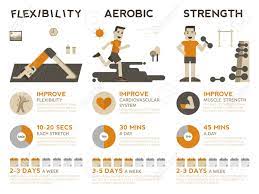Regular exercise is not only essential for maintaining a healthy lifestyle but also plays a vital role in preventing various chronic diseases and promoting overall well-being. However, exercise is not a one-size-fits-all solution, and different types of workouts offer distinct benefits for the body. In this article, we will explore three primary categories of exercise – Cardiovascular, Strength Training, and Flexibility – and delve into their unique advantages and how they contribute to a balanced fitness routine.
Cardiovascular Exercise:
- Definition and Explanation: Cardiovascular exercise, commonly known as cardio, refers to any activity that elevates the heart rate and sustains it for an extended period. During cardiovascular workouts, large muscle groups continuously receive oxygen and nutrients through increased blood circulation, enhancing the efficiency of the cardiovascular system.
- Types of Cardio Workouts: a. Running and Jogging: Running and jogging are classic forms of cardiovascular exercise that can be easily incorporated into a daily routine. Whether on a treadmill or outdoors, these activities improve endurance and boost heart health.
- Cycling: Cycling, whether on a stationary bike or outdoors, is a low-impact exercise that is gentle on the joints while offering excellent cardiovascular benefits.
- Swimming: Swimming is a full-body workout that engages all major muscle groups, providing an effective cardio session with minimal impact on joints.
- Dancing: Dancing is a fun and engaging way to get your heart pumping and offers a wide variety of styles to suit different preferences.
- Jump Rope: Jumping rope is a simple yet highly effective cardiovascular exercise that can be done anywhere, making it an ideal option for those with busy schedules.
- Health Benefits of Cardio Exercise: Cardiovascular exercise yields numerous health benefits, including:
- Improved heart health: Regular cardio workouts strengthen the heart muscle, reducing the risk of heart diseases.
- Weight management: Cardio exercises help burn calories, aiding in weight loss and weight maintenance.
- Increased stamina and endurance: As cardiovascular fitness improves, the body becomes more efficient at utilizing oxygen, leading to enhanced stamina.
- Stress reduction: Cardio workouts trigger the release of endorphins, the “feel-good” hormones that reduce stress and promote a positive mood.
Strength Training:
- Definition and Explanation: Strength training involves performing exercises that use resistance to build muscular strength, endurance, and power. It can involve using free weights, weight machines, or bodyweight exercises.
- Types of Strength Training Exercises: a. Bodyweight Exercises: Bodyweight exercises, such as push-ups, squats, and lunges, rely on your body’s weight as resistance and are effective for building functional strength.
- Weight Lifting: Weight lifting involves using external weights, such as dumbbells or barbells, to target specific muscle groups and increase muscle mass.
- Resistance Bands: Resistance bands offer a portable and versatile option for strength training, making it accessible for people of all fitness levels.
- Kettlebells: Kettlebell exercises challenge multiple muscle groups simultaneously and improve overall strength and stability.
- Health Benefits of Strength Training: Strength training offers several health benefits, including:
- Increased muscle mass and tone: Regular strength training leads to muscle growth and improved muscle definition.
- Enhanced bone health: Weight-bearing exercises stimulate bone growth and reduce the risk of osteoporosis.
- Boosted metabolism: Muscle tissue burns more calories than fat, leading to an increase in resting metabolic rate.
- Injury prevention: Strengthening the muscles around joints helps protect them from injuries and improves overall body stability.
Flexibility Training:
- Definition and Explanation: Flexibility training focuses on stretching and elongating muscles to improve joint range of motion. It is often neglected but is crucial for maintaining mobility and preventing injuries.
- Types of Flexibility Exercises: a. Static Stretching: Static stretches involve holding a position for a prolonged period, allowing muscles to elongate gradually.
- Dynamic Stretching: Dynamic stretches involve controlled movements that mimic the actions of a specific activity, helping to warm up the muscles and prepare the body for exercise.
- Yoga: Yoga combines physical postures, breathwork, and meditation to promote flexibility, balance, and relaxation.
- Pilates: Pilates focuses on core strength and flexibility through controlled movements that enhance overall body awareness.
- Health Benefits of Flexibility Training: Incorporating flexibility exercises into your routine provides various health benefits, including:
- Improved range of motion: Enhanced flexibility allows for better movement and reduces the risk of injuries.
- Reduced muscle tension: Regular stretching can alleviate muscle tightness and discomfort.
- Enhanced athletic performance: Increased flexibility can lead to better athletic performance and efficiency in sports and physical activities.
- Stress relief and relaxation: Flexibility exercises, such as yoga, promote relaxation and mental well-being.
Creating a Balanced Exercise Routine: Achieving a balanced exercise routine involves understanding your fitness goals, combining different types of exercise, and allowing adequate time for rest and recovery. Tailoring your workouts to your objectives ensures maximum effectiveness and keeps you motivated to stay on track.
Conclusion: Exploring and incorporating different types of exercise, including cardiovascular, strength training, and flexibility workouts, is essential for achieving overall health and fitness. Each type of exercise offers unique benefits for the body and contributes to a well-rounded fitness routine. By understanding the advantages of each category and combining them thoughtfully, you can create a customized exercise plan that aligns with your goals and leads to a healthier, happier lifestyle. Remember, consistency and determination are key on your journey to improved physical and mental well-being.
